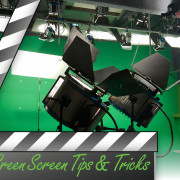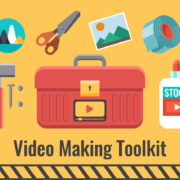De-mystified: What to Expect When Making a Professionally Produced Corporate Video
Short videos for websites, tradeshows, eBlast campaigns, social media and other delivery platforms are becoming larger portions of the marketing pie – exponentially, in some industries. So this article isn’t about the need for video – or how to do it yourself on your smartphone or GoPro.
Instead, we are going to cover the professional video production process from nose to tail – so when you do decide to produce a high-quality custom video you will know exactly how to proceed and what to expect.
Where do you begin?
This is often the biggest stumbling block and it’s the first step. It’s what seems to mystify the most. So where to begin? The first step before approaching a production company or agency for a proposal is to determine how long a video you need, and the range of your budget. Attention spans are getting shorter, so brevity is paramount. A good target length is two minutes – three minutes on the outside. 90 seconds would be even better.
If it’s a complicated subject, think of producing multiple short video “modules” instead of a 15-minute snooze-fest. Recent studies have shown that the most effective length for videos on platforms like Facebook and Instagram is from 6 to 30 seconds! That’s not a typo…6 seconds!
What do you like?
Next, find and bookmark a few videos on YouTube or Vimeo that you like or would like to emulate. They don’t even have to be related to your industry. Then write up a detailed outline of what topics you would like to cover – keeping in mind more than 3-5 major topics or points in a short video becomes an unwieldy mess.
A simple breakdown or outline of a video could look like this:
- Logo or title sequence with music swell (5-10 seconds)
- Introduction to the company, service or product (15-30 seconds)
- Key Point #1 (20-30 seconds)
- Key Point #2 (20-30 seconds)
- Key Point #3 (20-30 seconds)
- Summary or Call to Action (30 seconds)
- Final screen: web URL / Phone #, etc. (10 seconds)
As far as total running time is concerned, research has shown that for marketing videos you are generally better off shooting for the shorter end of the spectrum.
What does it cost?
As far as budgets are concerned, prices from production companies vary wildly but plan on spending at least $3,000 to $5,000 for a broadcast-quality finished product in HD or $4K with a moderate amount of bells and whistles. Three finished minutes of custom video for $5,000 is a good rule of thumb – depending on location, crew needs and the number of shoot days.
We realize that’s a healthy chunk of change. That’s because when all is said and done – from scripting to delivery of the final video – there are at least a few dozen hours of time invested – and significant outside costs for voice over professionals, music licensing and possibly other special services.
The value? Not only will a professionally produced video best represent your brand, but a strategically conceived video production can be deployed /repurposed on a variety of platforms, including websites, tradeshows, sales presentations/meetings YouTube, social media, eBlast campaigns and more.
How does the production process work?
The next big question to de-mystify. Let’s break it down into three key areas:
The Script
Generally, the video production people will take the outline you provided and flesh it out into a script for the voice over or on-camera talent. The script will most likely go back and forth a couple of times for approvals, revisions or tweaks. From there the script gets recorded by a professional narrator or on-camera host.
Note: It’s very important to really nail down the exact script verbiage because it gets expensive to make changes after everything has been recorded and edited. Trust us on this; it’s pure experience and wisdom.
The Shoot
Unless it is a complete 2D or 3D graphics production, there needs to be “video for the video”. Most short marketing or company overview videos are shot on location over the course of 1-2 days at a corporate office, plant, construction site or wherever the desired activity is taking place. It’s always good to get a few shots of every job or process for plenty of variety. Wide, establishing shots of the offices, lobbies or facilities are always a must.
A super-effective and flexible video production tool is green screen technology – where you can have the host of a video appear in multiple locations without the need for travel. With modern keying technology, equipment and techniques it can look very crisp and realistic, and can add another dimension to your project.
The Editing
So you have your script written, your narration recorded and your raw footage in the can…it’s editing time, people! There are two approaches: Let the video editor take all the assets and come up with a first cut for your review and revision, or sit with him or her the whole time.
Unless it is very technical subject matter, I strongly discourage the latter approach as it invariably takes way more time and having someone sit there often drives the editor nuts. Just the way it is. Some editors may want you to hold their hand the whole time, but that’s not who you need. A professional should drive the process at this point – with input from the producer as needed. Like the script, there will be a couple of rounds of back and forth, and then it’s a done deal!
How long will it take?
Video production time frames vary depending on scheduling, availability, script and video draft approvals and a number of other variables – some often unseen. That said, in a reasonable world the whole process should take about a month. Basically, a week each for scripting, shooting, editing and revisions/approval is a good rule of thumb. However, sometimes scripts or video draft approvals get hung up in corporate, legal or both for weeks at a time.
Naturally, time frames can be compressed – but that can often result in higher fees. Plan on a month or so for the process to unfold (if you can) and help keep everyone involved sane.
What formats are best for the final video?
Finished videos should be delivered in a few different formats. First and foremost, a full-resolution HD mp4 file that can be used for both uploads to YouTube and played from a computer or USB drive connected to a large screen TV; an HD Windows Media version for older PC media players that don’t play mp4s and a physical DVD – either standard or Blu-Ray.
Of course, every project is different, but these basics apply to the vast majority of short video productions. If you need a proposal for a project or want more information about any type of video production, contact Total Spectrum at 714.637.3600 and ask for Mark. (He is hell on wheels when he is half-drunk at the editing bay.)










